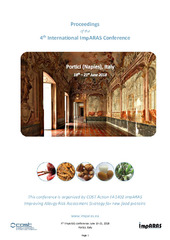Приказ основних података о документу
Digestomics of walnut and its nsLTPs allergens reveals their ultimate resistance to gastric digestion
| dc.creator | Prodić, Ivana | |
| dc.creator | Dubiela, Pawel | |
| dc.creator | Mihailović, Jelena | |
| dc.creator | Stanić-Vučinić, Dragana | |
| dc.creator | Smiljanić, Katarina | |
| dc.creator | Hoffmann-Sommergruber, Karin | |
| dc.creator | Ćirković-Veličković, Tanja | |
| dc.date.accessioned | 2023-10-10T10:40:49Z | |
| dc.date.available | 2023-10-10T10:40:49Z | |
| dc.date.issued | 2018 | |
| dc.identifier.uri | http://intor.torlakinstitut.com/handle/123456789/776 | |
| dc.description.abstract | Background: Sensitization to non-specific lipid transfer protein (ns-LTPs) in plant foods is regarded as a risk factor for generalized allergic reactions. Stability to gastric digestion represents very important parameter of food proteins allergenicity. Usually studies of digestion were carried out on purified proteins, but has never been examined the influence of different food matrices on different allergens. Allergens from the nsLTP family are known to share a characteristic structure which is highly resistant to proteolysis, and therefore, IgE cross-reactivity of nsLTPs needs to be investigated in the environment such as complex food matrix.Objective: The aim of this research project is to reveal how proteins are digested (by Minekus protocol) within the natural food matrix and possible consequences on their allergenicity, with the special focus on ns-LTP.Methods: Pure nsLTPs from walnut were labelled with Alexa 633 and added to whole grain of grounded raw walnuts, incubated with human α-amylase, and pepsin, therefore mimicking the effects of oral and gastric digestion, in total duration of 2h. Proteins extracted from the mixture were analyzed by one-dimensional (1D) and two-dimensional SDS-PAGe, and respective 1D and 2D immunoblots.Results: Most proteins from pepsin digested walnut sample were more resistant to digestion according to 1D SDS PAGE. Pepsin digested raw walnut sample with nsLTP were assessed by 2D PAGE to compare profiles of the digested and control sample (no pepsin added). 2D SDSPAGE of digested and control walnut samples showed almost identical profiles, especially in the context of fluorescently labelled nsLTP allergens. These results demonstrate substantial resistance of nsLTP allergens to gastric digestion since they remained mostly intact after 2 h of gastric (pepsin) digestion.Conclusion: Further research is needed to be able to grade stability/resistance of selected food allergens to gastric digestion as a consequence of food matrix modulating effects. We propose that certain combinations of foods and allergens could provide additional protection or on the contrary ease the digestion, by comparing trends between control and digested samples and between different digested combinations as well. | sr |
| dc.language.iso | en | sr |
| dc.publisher | IMPARAS Cost Action FA1402 | sr |
| dc.rights | openAccess | sr |
| dc.rights.uri | https://creativecommons.org/licenses/by/4.0/ | |
| dc.source | Proceedings of the 4th International ImpARAS Conference, Portici (Naples), Italy, June 19-21, 2018 | sr |
| dc.subject | Specific lipid transfer proteins | sr |
| dc.subject | panallergens | |
| dc.subject | walnut | |
| dc.subject | INFOGEST protocol | |
| dc.subject | gastric digestion | |
| dc.title | Digestomics of walnut and its nsLTPs allergens reveals their ultimate resistance to gastric digestion | sr |
| dc.type | conferenceObject | sr |
| dc.rights.license | BY | sr |
| dc.citation.epage | 59 | |
| dc.citation.spage | 59 | |
| dc.identifier.fulltext | http://intor.torlakinstitut.com/bitstream/id/1798/Digestomics_of_walnut_pub_2018.pdf | |
| dc.identifier.rcub | https://hdl.handle.net/21.15107/rcub_intor_776 | |
| dc.type.version | publishedVersion | sr |

